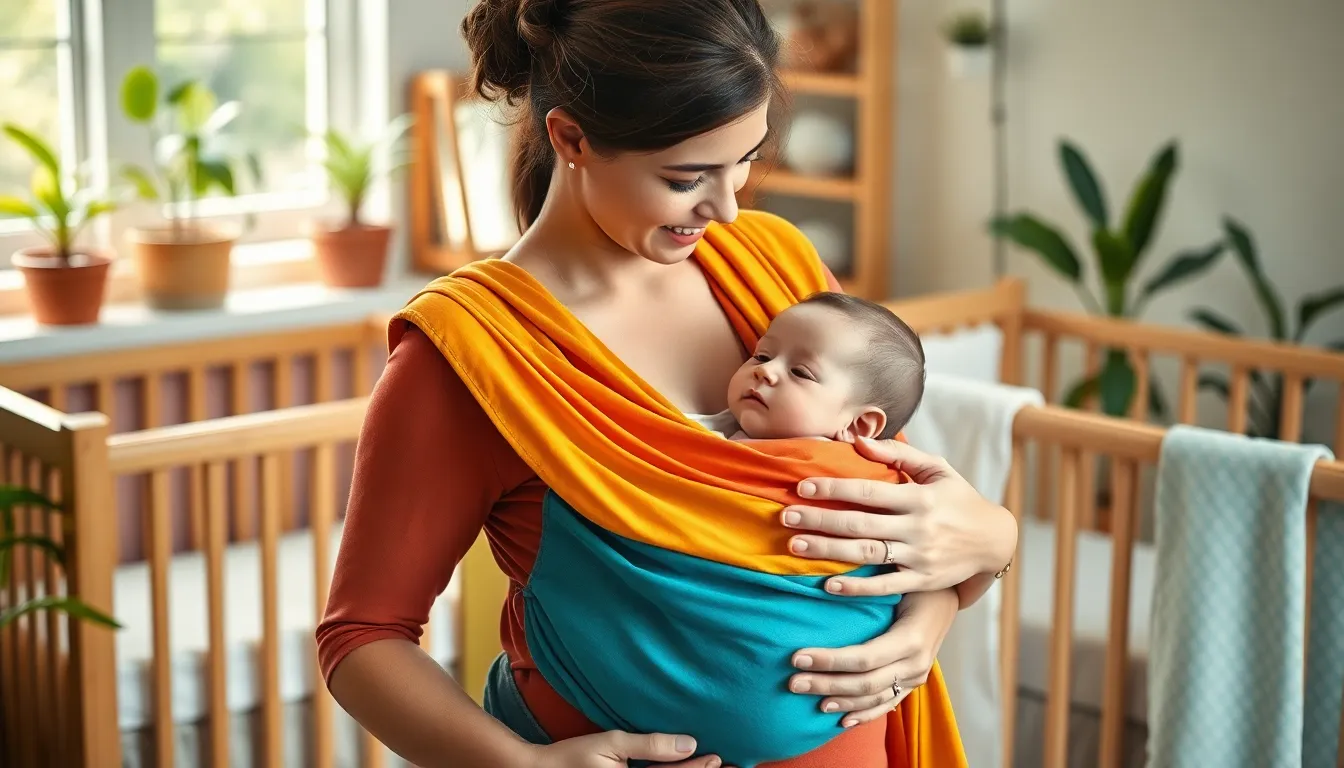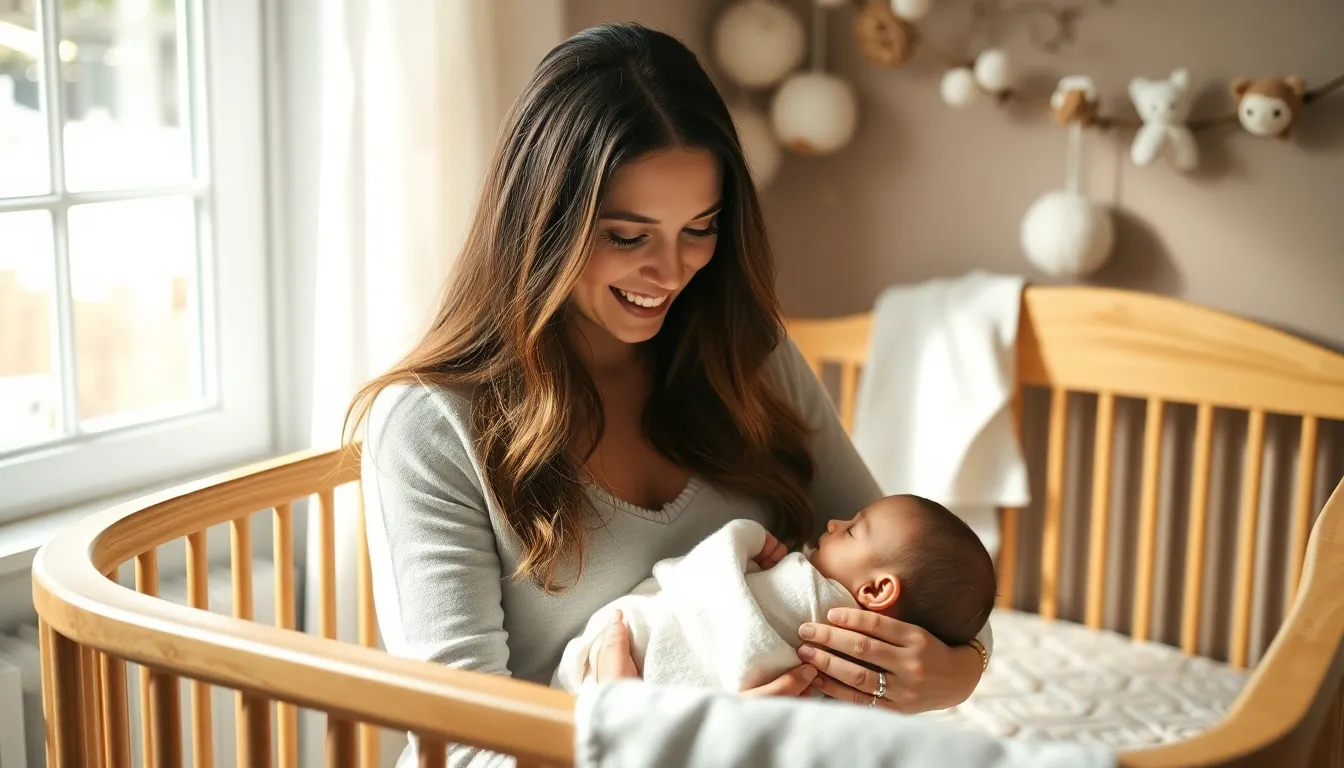Table of Contents
ToggleWhen it comes to baby gear, parents want the best for their little ones. But with so many products on the market, how can they ensure safety without sacrificing style? Enter non-toxic baby gear—the superhero of parenting products. It’s like finding a unicorn in a field of plastic dragons.
What Is Non-Toxic Baby Gear?
Non-toxic baby gear refers to products designed for infants that do not contain harmful chemicals, ensuring a safe environment. Common categories include cribs, strollers, toys, and clothing, all crafted with materials that meet strict safety standards. Parents often seek gear free from substances like phthalates, BPA, and formaldehyde.
Safety certifications play a vital role in identifying non-toxic products. Organizations such as the Consumer Product Safety Commission (CPSC) and the American Society for Testing and Materials (ASTM) help verify the safety of baby gear through rigorous testing. Trusted brands frequently display these certifications to assure parents of their commitment to safety.
Materials used in non-toxic baby gear typically include organic cotton, bamboo, and other eco-friendly substances. Organic cotton, grown without pesticides, reduces the risk of irritation on sensitive skin. Bamboo fabric, known for its natural antimicrobial properties, offers a sustainable alternative that benefits both children and the environment.
Design also matters when selecting non-toxic baby gear. Manufacturers often prioritize durability and functionality while ensuring that aesthetics do not compromise safety. Innovative designs can incorporate easy-to-clean materials and safety features, allowing parents to make informed choices.
Choosing non-toxic baby gear not only protects children’s health but also supports sustainable practices. By opting for eco-friendly products, parents contribute to a healthier planet for future generations. Responsible choices reflect a broader commitment to wellness, highlighting the importance of safety in every aspect of child-rearing.
Benefits of Non-Toxic Baby Gear

Non-toxic baby gear provides clear advantages for both children’s health and the environment. Products crafted without harmful chemicals create a safer space for infants.
Health and Safety
Many parents prioritize health and safety when selecting baby gear. Non-toxic items eliminate exposure to harmful substances like phthalates, BPA, and formaldehyde. Organic materials such as cotton and bamboo offer safety for sensitive skin. Enhanced safety standards from organizations like the CPSC and ASTM verify product safety. Infants benefit from using gear designed to minimize harmful effects on their developing bodies. Price, quality, and style often improve when using safer materials, allowing parents to focus on both aesthetics and well-being.
Environmental Impact
Sustainable practices emerge as a key reason to choose non-toxic baby gear. Production processes for eco-friendly materials reduce pollution and waste. By opting for organic cotton and bamboo, manufacturers help maintain biodiversity and protect ecosystems. Non-toxic products typically use biodegradable materials, resulting in less landfill waste. Parents influence a healthier planet by choosing sustainable options for their children. Selecting gear with eco-certifications encourages broader environmental responsibility and supports ethical consumption.
Types of Non-Toxic Baby Gear
Non-toxic baby gear includes a variety of products designed to create a safe environment for infants while prioritizing health and comfort. These essential items range from cribs to toys, all crafted with child safety in mind.
Cribs and Mattresses
Cribs and mattresses often require careful selection. Non-toxic cribs typically use finishes free from harmful chemicals, ensuring a safe sleeping environment. Natural materials, such as solid wood, avoid synthetic components. Mattresses made from organic cotton or natural latex avoid harmful flame retardants and adhesives. Look for certifications like Greenguard Gold, indicating low emissions and safety standards.
Strollers and Car Seats
Strollers and car seats contribute significantly to infant safety on the go. Many non-toxic options use eco-friendly fabrics and plastics without BPA or phthalates. Safe harness systems and chemical-free upholstery offer additional peace of mind. Parents should verify safety certifications, such as those from the CPSC or ASTM, before making a purchase. Lightweight designs often enhance usability without sacrificing safety or comfort.
Toys and Bedding
Toys and bedding play a vital role in ensuring a non-toxic environment for infants. Natural rubber or organic cotton toys avoid toxic materials, promoting safe play. Bedding options, like organic sheets and blankets, ensure comfort without harmful chemicals. Certifications such as Oeko-Tex indicate safety standards in manufacturing. Choosing toys and bedding crafted from safe materials not only promotes health but also supports eco-conscious practices.
How to Choose Non-Toxic Baby Gear
Selecting non-toxic baby gear requires careful consideration of safety certifications and materials. Focusing on these factors ensures a safe environment for infants while minimizing exposure to harmful substances.
Important Certifications
Certifications verify the safety of baby gear. Examples include the Greenguard Gold certification, ensuring minimal emissions of harmful chemicals. Another critical certification comes from the Consumer Product Safety Commission (CPSC), which establishes strict safety standards. Organizations like the American Society for Testing and Materials (ASTM) also play a role in setting benchmarks for product safety. Parents should always check for these certifications when choosing products, as they provide a reliable assurance of non-toxic materials and construction. Trusting these labels helps families make informed decisions about the safety and quality of baby gear.
Material Considerations
Material choice significantly impacts a product’s safety. Organic cotton and bamboo are popular choices, being both gentle on sensitive skin and environmentally sustainable. Avoiding materials that contain phthalates, BPA, or formaldehyde can enhance child safety. Many parents prefer items constructed from natural wood, which reduces exposure to harmful chemicals found in synthetic alternatives. Exploring fabric options is essential; choosing non-toxic dyes protects infants from harmful substances. A thorough examination of materials contributes to a healthier environment for children while supporting eco-friendly practices in manufacturing.
Choosing non-toxic baby gear is a vital step for parents dedicated to providing a safe and healthy environment for their little ones. By prioritizing products free from harmful chemicals, parents not only protect their children’s health but also contribute to a sustainable future. The availability of stylish options ensures that safety doesn’t come at the cost of aesthetics.
Investing in non-toxic gear reflects a commitment to quality and ethical consumption. As parents navigate the marketplace, they can feel confident knowing that their choices support both their child’s well-being and the planet. Embracing non-toxic baby gear is more than a trend; it’s a responsible decision that fosters a healthier world for generations to come.




